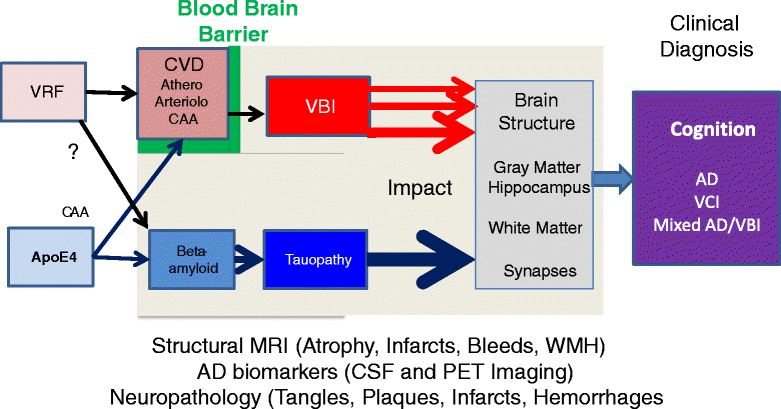Clinical and imaging features of mixed Alzheimer and vascular pathologies
- PMID: 25722748
- PMCID: PMC4342006
- DOI: 10.1186/s13195-015-0104-7
Clinical and imaging features of mixed Alzheimer and vascular pathologies
Abstract
The co-occurrence of both Alzheimer disease (AD) pathology and vascular brain injury (VBI) is very common, especially amongst the oldest of old. In neuropathologic studies, the prevalence of AD, VBI, and mixed AD/VBI lesions ranks ahead of Lewy bodies and hippocampal sclerosis. In the modern era of structural magnetic resonance imaging (MRI) and amyloid positron emission tomography (PET) imaging, this review examines 1) the prevalence of mixed AD and VBI pathology, 2) the significance of these pathologies for cognitive impairment (AD and vascular cognitive impairment (VCI)), and 3) the diagnosis and treatment of mixed AD/VCI. Although epidemiologic studies report that vascular risk factors for arteriosclerosis increase the risk of incident AD, both autopsy and amyloid PET studies indicate that AD and VBI contribute additively, but independently, to the risk of dementia. The literature confirms the malignancy of AD and highlights the adverse effects of microinfarcts on cognitive function. For the clinical diagnosis of mixed AD/VCI, the presence of AD can be recognized by neuropsychological profile, structural imaging, cerebrospinal fluid biomarkers, and glucose PET and amyloid PET imaging. The diagnosis of VBI, however, still hinges predominantly on the structural MRI findings. Severe amnesia and atrophy of the hippocampus are characteristic of early AD, whereas the cognitive profile for VCI is highly variable and dependent on size and location of VBI. The cognitive profile of mixed AD/VBI is dominated by AD. With the notable exception of microinfarcts (which elude in vivo detection), infarcts, hemorrhages, and white matter hyperintensities on structural MRI currently represent the best markers for the presence VBI. Better markers that reflect the health and reactivity of intracerebral blood vessels are needed. For prevention and treatment, the type of underlying cerebrovascular disease (for example, arteriosclerosis or cerebral amyloid angiopathy) should be considered. It is likely that reduction of vascular risk factors for arteriosclerosis can significantly reduce vascular contributions to mixed dementia.
Figures

References
-
- Gorelick PB, Scuteri A, Black SE, Decarli C, Greenberg SM, Iadecola C, et al. Vascular contributions to cognitive impairment and dementia: a statement for healthcare professionals from the American Heart Association/American Stroke Association. Stroke. 2011;42:2672–713. doi: 10.1161/STR.0b013e3182299496. - DOI - PMC - PubMed
-
- Sperling RA, Aisen PS, Beckett LA, Bennett DA, Craft S, Fagan AM, et al. Toward defining the preclinical stages of Alzheimer’s disease: recommendations from the National Institute on Aging-Alzheimer’s Association workgroups on diagnostic guidelines for Alzheimer’s disease. Alzheimers Dement. 2011;7:280–92. doi: 10.1016/j.jalz.2011.03.003. - DOI - PMC - PubMed
-
- Albert MS, DeKosky ST, Dickson D, Dubois B, Feldman HH, Fox NC, et al. The diagnosis of mild cognitive impairment due to Alzheimer’s disease: recommendations from the National Institute on Aging-Alzheimer’s Association workgroups on diagnostic guidelines for Alzheimer’s disease. Alzheimers Dement. 2011;7:270–9. doi: 10.1016/j.jalz.2011.03.008. - DOI - PMC - PubMed
-
- McKhann GM, Knopman DS, Chertkow H, Hyman BT, Jack CR, Jr, Kawas CH, et al. The diagnosis of dementia due to Alzheimer’s disease: recommendations from the National Institute on Aging-Alzheimer’s Association workgroups on diagnostic guidelines for Alzheimer’s disease. Alzheimers Dement. 2011;7:263–9. doi: 10.1016/j.jalz.2011.03.005. - DOI - PMC - PubMed
Grants and funding
LinkOut - more resources
Full Text Sources
Other Literature Sources

